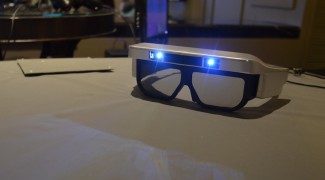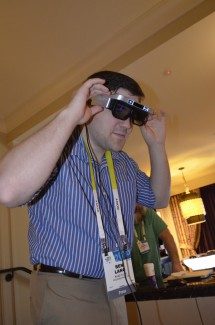Technical Illusions recently began shipping their first early, pre-production sets of castAR augmented reality glasses to backers. We met up with the team at CES 2015 and got the chance to try out the new hardware. Here’s what we saw.
It’s a cliche that you can’t tell someone what using virtual reality is like, they have to try it for themselves to truly understand. But if you thought it was tough describing the delights of VR to the uninitiated, try getting people to wrap their minds around the unique experience that is castAR.


For those not in the know, castAR is a technology that uses dual projectors to project a 720p, stereoscopic image onto special, retro-reflective material allowing you to see the projected game-world in front of you in 3D. The practical upshot of this is, you can throw a retro-reflective sheet onto any surface, vertical, horizontal or otherwise. Even cleverer though, if you add a friend with their own pair of castAR glasses, when they put them on and stare at the same surface they receive their own view of the game. The surfaces property mean that light is reflected back to the source, i.e. the user.
See Also: CES 2015: We Talk CastAR with Jeri Ellsworth and Rick Johnson (Plus: ‘Toby the Cat’ Health Update)
Your position relative to the surface and the projected image is provided by a tracking marker, placed somewhere in the play area. IR LEDs on the marker are picked up by a camera on the bridge of the player’s glasses and used to extrapolate translation information. This means, you can move freely around the play space and the game view will shift as expected.
The Technical Illusions team had a demo table setup covered with a strip of retro’ material and two sets of the latest glasses to try out. There a new game to try too, a Marble Madness (1984) inspired multiplayer action game. The aim was simple enough, race your marble to the exit against your opponent’s trying not to tumble off the track into the abyss, avoiding obstacles on the way. Exec. Editor Ben Lang and I were pitted against each other, both (of course) wearing castAR glasses and armed with X-box 360 controllers.
Glancing over to the table and the retro’ surface, it’s initially a little disconcerting to see the game world take over the table. As I shifted around the table, I peered down through the table’s surface into the projected world , in this case a twisting assault course suspended high above the earth.


As I got to grips with my marble’s (stop sniggering at the back) handling characteristics, I consciously stooped and peered into the scene, trying to throw off the tracking. It was pretty solid, only breaking when I dropped below the surface of the table, where the marker sat. Although Ben and I were racing on separate paths on the same course, he had an entirely separate view from me following his own troublesome sphere. The scene is modelled in 3D space of course, and occasionally you’ll find yourself ducking around collections of hot-air balloons that obstruct your view, a neat trick which helps sell the illusion of depth nicely.
At this point it’s worth pointing out that the combination of bright projectors and the unique properties of the retro-reflective material mean it’s possible to play with castAR in ambient light. Our time with castAR was at around midday and there were lamps and outside sources of ambient light, yet the projected world was clearly visible. As this is projected light however, playing this way means that contrast ratio is lacking, although your brain does a good job of adjusting – I’m looking forward to seeing castAR in blacked out conditions!
As you can see in the somewhat shaky footage we captured, wherever there’s retro’ material, there’s another window into the game world. Once people start receiving the final systems later in the year, I can foresee a raft of one-upmanship as castAR fans post pictures of their play space setups.
The experience isn’t quite perfect of course, the system is still in development. There is noticeable latency when shifting your head, as the projected view catches up with your head’s physical position. However, I didn’t find this to be much of a problem at all once playing. Nevertheless, the team is hard at work trying to drive that latency down. castAR in some ways has a tougher challenge with latency. When you can see your world updating in realtime you have a tough target to beat.
Unfortunately, we’re still yet to try the VR Clips, an add on that converts castAR from an augmented reality to a virtual reality system by reflecting projected light directly back to your eyes, as this is still in development. Now that the majority of design and fabrication issues are behind them, VR Clips are No. 1 on their priority with real emphasis being placed on the feature. Also, accessories such as the ‘wand’, allowing you to reach into the game to control and manipulate a game, wasn’t yet playable. The team were optimistic about castAR’s VR capabilities, extending it’s practical uses and adaptability further.
Technical Illusions have grown in the last 12 months since last we met and seem to really have a handle on where they’re going and what needs to be done to get the final glasses out to Kickstarter backers and, ultimately, to retail. Although the team won’t be drawn on exactly when that shipping date will be, it’s fairly clear that they’re unlikely to ship anything until they’re completely happy with the product.
castAR remains a unique and exciting hardware platform for gaming, with a truly social focus on multiplayer and potentially family based activities seemingly it’s real forte. The nature or AR means you’re less isolated from other players – the potential for castAR to replace activities such as traditional board-gaming for example is enticing. What we saw was undoubtedly cool and as long as elements such as latency can be tweaked yet further and the software support for the device comes on stream, the final product will wow those who try it we’re sure. We look forward to getting our hands on the final units at some point this year.

